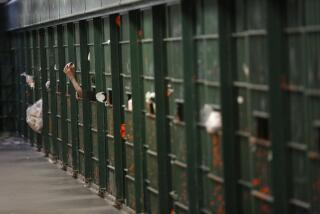Editorial: Treatment, not just jail, for the mentally ill
- Share via
The U.S. Department of Justice and Los Angeles County officials are negotiating the details of a consent decree to govern the treatment of mentally ill inmates in the troubled county jails, following more than a decade of reported abuse and excessive force by sheriff’s deputies. The final terms will surely carry a price tag, but that’s hardly news. The county — or more to the point, county taxpayers — already have paid hundreds of millions of dollars for settlements and verdicts arising from the abuse of people struggling with mental health problems.
That’s something members of the Board of Supervisors will no doubt have on their minds Tuesday as Dist. Atty. Jackie Lacey presents a plan for diversion of mentally ill offenders, who currently account for as much as 40% of the jail population. Of course it will be costly. No proposal for properly dealing with people suffering from mental illness — from the time they are reported for petty crimes, to their arrest, to transport to properly staffed urgent care centers, to treatment by qualified community-based providers and support after discharge — can be implemented without substantial funding. But such an investment would be wiser, more effective and more humane — and, by the way, less outrageously immoral — than waiting to spend that same money, and more, on lawsuits over the neglect or abuse of people whose crimes are a result of their illnesses.
Another issue the supervisors appear to understand is the degree to which the social ills that fall within the county’s purview are intertwined. Petty crime, homelessness, veterans’ post-traumatic stress, jail management, drug abuse, excessive use of force and mental illness — although generally seen as distinct challenges, they are often merely different aspects of the same problem and often affect the same populations. Better, earlier and more effective treatment and diversion of nonviolent mentally ill offenders from jail are proper in their own right but may also reduce crime by curbing criminal recidivism, reduce inmate abuse by keeping many sick and harder-to-manage people out of jail, and reduce homelessness by intercepting patients earlier in their passage through the criminal justice system and social service network.
One of the strengths of Lacey’s plan is that it recognizes the interrelatedness of such problems. It could stand to go even further in that direction, but a more integrated and critical evaluation of the county’s existing programs may fall more in the Board of Supervisors’ ambit than the district attorney’s. Lacey’s plan is best seen as merely one component of a process that may take decades and cost millions of dollars — and yet be a bargain when compared with the status quo.
Follow the Opinion section on Twitter @latimesopinion and Facebook
More to Read
A cure for the common opinion
Get thought-provoking perspectives with our weekly newsletter.
You may occasionally receive promotional content from the Los Angeles Times.










